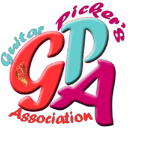🎸 Chet Atkins
The Fingerpicking Master and Nashville Legend
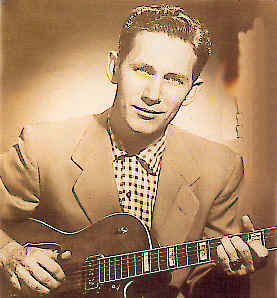
Chet Atkins, master of fingerpicking and Nashville legend
Chester Burton Atkins (1924-2001)
Adored by some, hated by others, praised for his fingerpicking guitar talents, criticized for the heavy-handed producer approach he exercised in post-war Nashville, showing firmness and obstinacy, Chet Atkins is a complex character with multiple and often contradictory facets.

🏡 Childhood and Musical Training
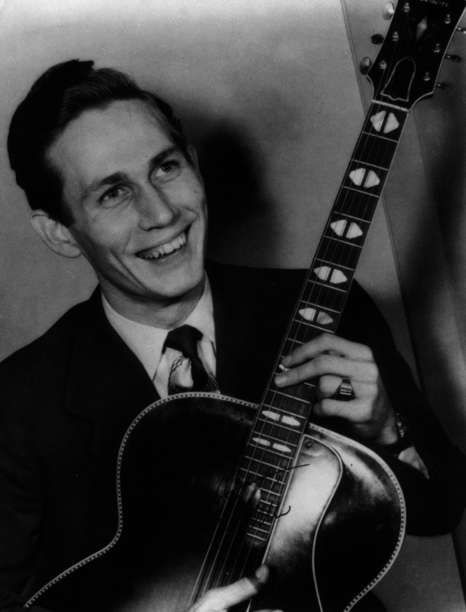
Chet's father, Wes Atkins, was a music teacher, occasional evangelist preacher, and former railroad worker, the only activity in Luttrell, a small town in eastern Tennessee where he lived.
Wes married five times and had several children with each of his wives. Chet was the third child of Wes's second marriage to Ida, a gospel singer and pianist whom he would divorce six years later.
Chet's childhood was harsh, evolving between great poverty, very strict education, and a life torn between father and mother. He also suffered from severe asthma that forced him to stay bedridden for long periods each year.
His father, who deeply despised country musicians as "ignorant and debauched," taught him the basics of musical notation. But it was his half-brother Jimmy Atkins and his stepfather Willie Strevel, a locally renowned musician, who taught him guitar, an activity Chet practiced intensively during his periods of isolation.
He listened to records by the Carter Family, Jimmie Rodgers, and Blind Lemon Jefferson.
🎵 Discovery of Fingerpicking and Influences
In 1935, Chet left school and worked on the family farm. But he quickly discovered that he earned much more from tips collected while playing outside the local drugstore.
Chet listened to all radio shows where guitar could be heard and picked up ideas from Les Paul playing with Jimmy Atkins, George Barnes, Lonnie Johnson, Eddie Lang, Django Reinhardt...
But the one who marked him most was Merle Travis who hosted a radio show widely broadcast throughout the South from Cincinnati.
Chet quickly managed to imitate Travis's style, but where Travis played with two fingers, Chet used four, one of the very rare examples of this type of fingerpicking.
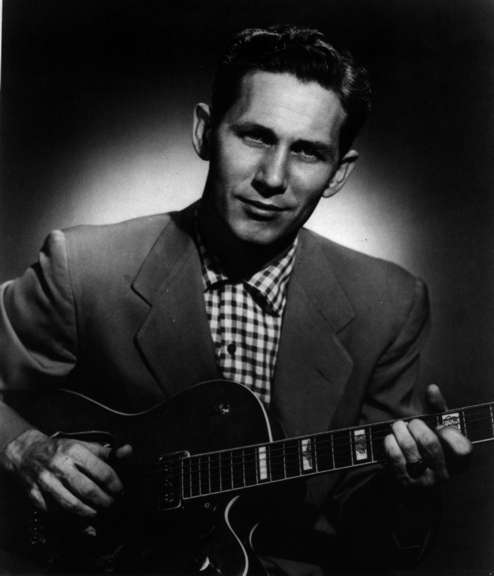
📻 First Jobs and Professional Development
In 1942, Chet Atkins managed to get his first professional musician job: participating in the famous radio show "Merry Go Round" in Knoxville, an important Tennessee center.
He was tasked with playing a different guitar tune at the beginning of each daily program. This forced Chet to considerably expand his repertoire and draw well beyond country music: he interpreted Merle Travis, Riley Puckett but also Django Reinhardt, Charlie Christian, and Andres Segovia.
🎷 Jazz Experience
This led him to briefly participate in a local jazz orchestra, the Dixieland Swingsters. In a few months, Chet became even more familiar with jazz chords and harmonic progressions.
In 1943, he visited his brother Jimmy who was then in New York. There he met his idol Les Paul, who was sufficiently impressed by the young man to take him jamming in all the jazz clubs in Manhattan.
When Chet returned to the South, he was much more confident and possessed a Gibson L-10, a gift from Jimmy!
💿 Recording Debut and Recognition
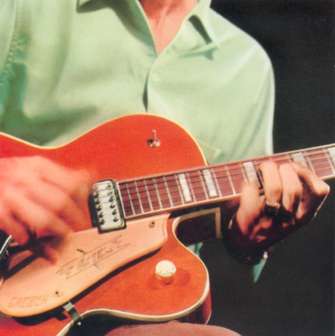
Atkins had no trouble finding work in several country music orchestras, notably those of Bill Carlisle and Red Foley.
It was with some of Foley's musicians that Chet managed to record a 78 rpm in 1946 for the small Nashville label, Bullet.
"Guitar blues" had little success but managed to attract the attention of RCA producers, notably Steve Sholes, who were trying in vain to find a competitor to Merle Travis in Nashville, who was reaping success after success in Hollywood.
Meanwhile, Atkins had married and named his daughter Merle, in homage to his idol.
🌟 The Golden Age of Recordings
Starting in August 1947, Atkins recorded a series of records where he sang (quite poorly) but played remarkably, in a style openly copying Merle Travis.
However, Chet's personal talents exploded in masterpieces like:
- "Canned Heat" - a formidable guitar version of a Bob Wills composition
- "Mite Heat" - the exceptional
- "Dizzy Strings"
- "Bug Dance" - an old Southern folklore tune
- "The Nashville Jump"
- "Centipede Boogie"
- "Galloping Guitar" - which was Atkins' first real commercial success
The following years would see "Yakety Axe," "Prissy," or "Country Gentleman."
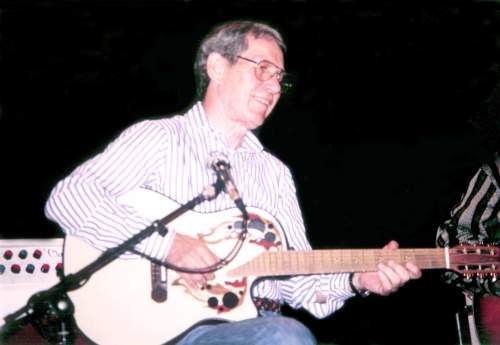
🎭 Nashville and the Grand Ole Opry
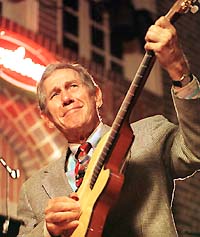
There were many excellent guitarists in Southeast country music, but none had Chet's versatility, jazz experience, or imagination.
From 1950, Chet Atkins settled permanently in Nashville, regularly participated in the Grand Ole Opry. He was everywhere and recorded with Homer & Jethro, the Carter Sisters (Maybelle Carter's daughters, one of the Carter Family's creators), George Barnes, Faron Young, Webb Pierce, Hank Williams, and dozens of others.
RCA (and Steve Sholes) engaged in creating increasingly commercial country music with the goal of "placing" as many titles as possible in the Top 40 charts.
Chet, with broad musical ideas, was gradually associated with production and then the financial side of this enterprise. He thus produced some of the biggest hits by Hank Snow, Jim Reeves, and Eddy Arnold.
👑 The Elvis Era and Rock'n'Roll
🎸 Historic Moment
When RCA signed Elvis Presley in November 1955, the label entrusted Atkins with the Memphis singer's first session. "Heartbreak Hotel" is not only one of rockabilly's masterpieces but also generated enormous sales.
Atkins' guitar (who would participate in many other Rock'n'roll sessions, notably behind Janis Martin) would serve as a model for countless guitarists in the emerging rock music.
With these commercial successes, Atkins became truly indispensable. His imprint is palpable on almost all country music of the 50s and 60s.
🏢 The Nashville Sound and Commercial Empire
He was thus one of the main designers of the Nashville Sound, this mixture of sweet pop and country (less and less salty) for better and (often) for worse.
Nashville eventually attracted to its studios some of the biggest names in American variety like Perry Como or Al Hirt, whom Chet produced.
In 1968, Chet succeeded Steve Sholes, who had just died, as vice-president of the major record company.
🎼 The Artist and His Instrumentals
Meanwhile, Atkins never stopped recording under his name. He abandoned all pretension to sing and concentrated on elaborate, virtuosic instrumentals, touching all genres, approaching all musical shores.
But by moving notably away from country's original soil, his music took on an icy elegance that seemed to frost all emotion.
While his fingerpicking playing was always admirable, the frequent absence of feeling meant his countless records ended up mainly being used as background music.
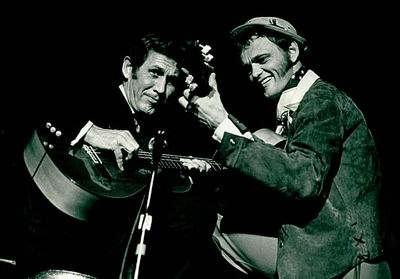
💿 Discography and Collaborations
Chet Atkins recorded more than six hundred titles. He often went astray in abominable records like the trying "Picks on the Beatles" (RCA) or the despairing "The night Atlanta burned" (RCA) recorded with a symphony ensemble.
But, on several occasions, he rediscovered the more earthy ways of his beginnings, notably in his duo albums with:
- Merle Travis - the excellent "Atkins-Travis Travelling show" (RCA)
- Les Paul
- Hank Snow
- Doc Watson - "Reflections" (RCA)
- Jerry Reed
- Mark Knopfler (in: "Neck and Neck" - Columbia)
🏆 Recognition and End of Career
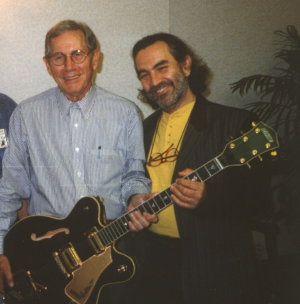
Atkins, increasingly a businessman, was overwhelmed with awards and was inducted into the Country Music Hall of Fame.
The anti-Nashville Sound reaction of the 70s was strongly directed against him and his production methods. He would acknowledge his mistakes, admitting he had probably gone too far in his quest for recognition and respectability for country music.
He even left RCA in 1982 to content himself with playing and recording under his name.
Despite failing health, Atkins never stopped being active.
🌟 Legacy and Influence
🎸 Impact on Marcel Dadi
His influence was enormous on the course of country music history, on the spread of fingerpicking guitar playing (the Frenchman Marcel Dadi was one of his best disciples) and his work, however uneven it may be, nonetheless contains numerous remarkable moments.
📀 Essential Albums
The first part of his career, the most earthy, is very well represented on the essential box set "Galloping guitar" (Bear Family).
- "The RCA Years" (RCA)
- "The Essential Chet Atkins" (RCA) - gather most of his commercial successes between 1947 and 1981
- "Jazz from the Hills" (Bear Family)
- "Stay tuned" (Columbia) - offer two of his best jazz sessions
👨👦 Jimmy Atkins - The Influential Brother
As for Jimmy Atkins (1918), the older half-brother who was at the origin of Chet's vocation, he also leaves a small but significant body of work.
First as an accompanist to Fred Waring and especially Les Paul, with whom he recorded substantially, playing guitar and violin and singing.
Then, in Chet's company, with whom he recorded many albums in the 40s and 50s. Finally, as a disc jockey in Birmingham (Alabama) and manager of the group the Dixie Range Riders.
Between 1949 and 1953, he recorded a handful of remarkable titles that clearly announced rockabilly ("Juke joint Johnny," "I'm a ding dong daddy").
📍 Guitar Pickers Association
Chet Atkins remains an iconic figure of picking, having inspired Marcel Dadi and generations of guitarists. Discover the passion of fingerpicking with Guitar Pickers Association.
